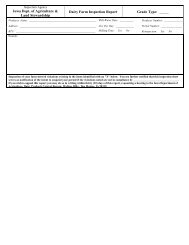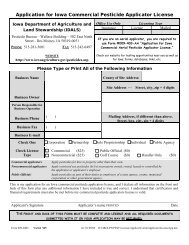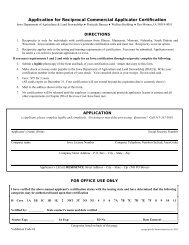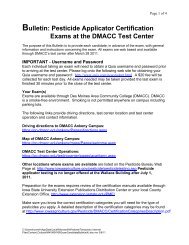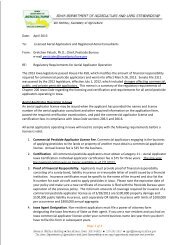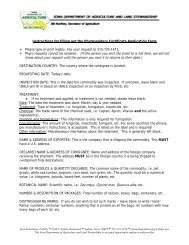Exhibit C: Detailed Background, Work Group Recommendations
Exhibit C: Detailed Background, Work Group Recommendations
Exhibit C: Detailed Background, Work Group Recommendations
You also want an ePaper? Increase the reach of your titles
YUMPU automatically turns print PDFs into web optimized ePapers that Google loves.
DETAILED BACKGROUND: WORK GROUP 4, STORMWATER WORK GROUP RECOMMENDATIONS<br />
September 2009<br />
STORMWATER REGULATION:<br />
Recommendation A – Utilize a Phase‐In Approach to Implement Statewide Stormwater Standards<br />
Consistent with the Iowa Stormwater Management Manual<br />
The State should require all cities and counties to implement stormwater management practices<br />
consistent with the Iowa Stormwater Management Manual (ISMM). Communities and counties<br />
should be given the opportunity to develop a phased‐in approach to allow sufficient time to<br />
secure necessary technical and financial assistance for effective implementation.<br />
The ISMM presents planning and design guidelines for the management of stormwater quality<br />
and quantity in the urban environment, and encourages the use of enhanced design practices<br />
for stormwater management, including best management practices and low impact<br />
development (LID). Iowa‐specific and part of the Iowa Statewide Urban Designs and<br />
Specifications (SUDAS) Manual, the ISMM outlines eleven minimum standards as community<br />
development guidelines.<br />
Three Iowa communities (Spirit Lake, Okoboji and Wahpeton) and Dickinson County have<br />
adopted ordinances requiring LID in new construction to improve water quality. Further, the<br />
ordinances require LID practices to comply with ISMM design standards.<br />
Statewide stormwater management standards should be applicable to new development,<br />
retrofits, redevelopment, and improvements to property.<br />
The phased‐in approach could begin with:<br />
• The 43 communities and three universities with municipal separate storm sewer systems<br />
(MS4s)<br />
• Communities over 10,000 and counties greater than 20,000 in population<br />
• Communities under 10,000 and counties under 20,000 in population<br />
Two alternative approaches to consider include beginning with flood‐impacted communities<br />
first, then MS4s, communities over 10,000 and so on. A second alternative phase‐in approach<br />
could utilize population levels and growth rates. Census information from the State Data Center<br />
of Iowa could be used to chart population, growth rates, etc. 5<br />
Before a city or county is required to implement statewide stormwater standards, they should<br />
be directed to the educational resources for stormwater management (see Recommendation<br />
H). Additionally, enhanced funding and mechanisms for raising those funds are needed (see<br />
<strong>Recommendations</strong> D‐G).<br />
5 State Data Center of Iowa, www.iowadatacenter.org<br />
83



![Ch 44, p.1 Agriculture and Land Stewardship[21] IAC 4/23/08 - Iowa ...](https://img.yumpu.com/49992480/1/171x260/ch-44-p1-agriculture-and-land-stewardship21-iac-4-23-08-iowa-.jpg?quality=85)

